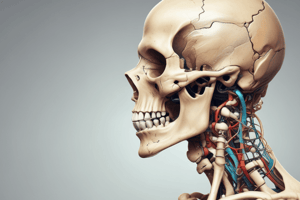Podcast
Questions and Answers
What is the primary function of the articular disc in the TMJ?
What is the primary function of the articular disc in the TMJ?
- To connect the temporal bone and mandible
- To limit lateral movements of the mandible
- To facilitate smooth movement between the joint surfaces (correct)
- To provide passive stability to the joint
Which ligament in the TMJ runs from the styloid process to the angle of the mandible?
Which ligament in the TMJ runs from the styloid process to the angle of the mandible?
- Articular ligament
- Sphenomandibular ligament
- Temporomandibular ligament
- Stylomandibular ligament (correct)
What type of motion is NOT performed by the mandible?
What type of motion is NOT performed by the mandible?
- Protrusion
- Retrusion
- Rotation (correct)
- Elevation
Which component of the TMJ is a fibrous membrane that surrounds the joint?
Which component of the TMJ is a fibrous membrane that surrounds the joint?
What is a common symptom of myofascial pain associated with TMJ?
What is a common symptom of myofascial pain associated with TMJ?
Which bony landmark is a depression in the temporal bone where the mandible sits?
Which bony landmark is a depression in the temporal bone where the mandible sits?
Which condition is characterized by a dislocated jaw or a displaced disc?
Which condition is characterized by a dislocated jaw or a displaced disc?
What articulation occurs when the mandible moves downward and back up?
What articulation occurs when the mandible moves downward and back up?
In TMJ function, which movement allows the jaw to move side to side?
In TMJ function, which movement allows the jaw to move side to side?
Which of the following ligaments may limit extreme lateral movements of the mandible?
Which of the following ligaments may limit extreme lateral movements of the mandible?
Flashcards
Articular capsule
Articular capsule
A fibrous membrane that surrounds the temporomandibular joint (TMJ). It attaches to the articular eminence, articular disc, and neck of the mandibular condyle.
Synovial tissue
Synovial tissue
Connective tissue lining the inside of the joint capsule. It produces synovial fluid, which lubricates the joint.
Articular disc
Articular disc
A fibrous extension of the capsule that sits between the articular surfaces of the TMJ. It's biconcave and allows the condyle to move within the joint.
Ligaments of the TMJ
Ligaments of the TMJ
Signup and view all the flashcards
Mandibular glenoid fossa
Mandibular glenoid fossa
Signup and view all the flashcards
Articular eminence
Articular eminence
Signup and view all the flashcards
Mandibular condyle
Mandibular condyle
Signup and view all the flashcards
Depression and elevation
Depression and elevation
Signup and view all the flashcards
Lateral deviation
Lateral deviation
Signup and view all the flashcards
Myofascial pain
Myofascial pain
Signup and view all the flashcards
Study Notes
Temporomandibular Joint (TMJ) Components
- Articular Capsule: Surrounds the joint, attaching to the articular eminence, articular disc, and mandibular condyle. It encloses the joint.
- Synovial Tissue: Lines the inner surface of the articular capsule and is a connective tissue. This tissue aids in joint lubrication, essential for smooth movement.
- Articular Disc: A biconcave fibrous structure positioned between the temporal bone and the mandible. It facilitates smooth articulation, evenly distributing the load and preventing direct bone-on-bone contact. The disc is made up of dense fibrous connective tissue.
- Ligaments: Providing passive support and stability to the TMJ. Includes the stylomandibular ligament, running from the styloid process to the mandibular angle. Also, the sphenomandibular ligament, extending from the sphenoid bone to the mandible’s lingula. These ligaments restrict excessive or abnormal movements of the mandible.
- Mandibular Glenoid Fossa: A depression in the temporal bone, accommodating the condyle of the mandible. Covered in smooth cartilage, facilitating jaw movement
- Articular Eminence: Located anterior to the fossa, a sloping bony eminence that receives the mandibular condyle during jaw opening. Covered in cartilage, permitting smooth movement.
- Mandibular Condyle: Part of the mandible that articulates with the TMJ, exhibiting dense cortical bone. Covered in dense connective tissue and cartilage enabling smooth and controlled movement within the joint.
TMJ Movements
- Depression and Elevation: Upward and downward movement of the mandible (e.g., opening and closing the mouth).
- Lateral Deviation: Side-to-side movement of the mandible (e.g., moving the jaw from side to side).
- Protrusion and Retrusion: Forward and backward movement of the mandible (e.g., jutting the jaw forward or bringing it back).
Common TMJ Problems
- Myofascial Pain: The most prevalent TMJ condition, discomfort or pain affecting muscles controlling jaw function.
- Internal Derangement: Includes dislocated jaw, displaced articular disc, or condyle injury. This impairs normal joint function and cause pain.
- Degenerative Joint Disease: Conditions like osteoarthritis or rheumatoid arthritis affecting the TMJ, leading to deterioration of the joint.
Studying That Suits You
Use AI to generate personalized quizzes and flashcards to suit your learning preferences.




